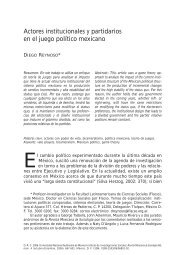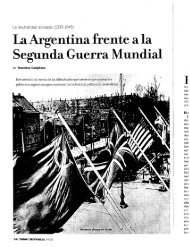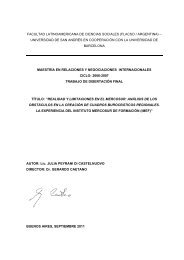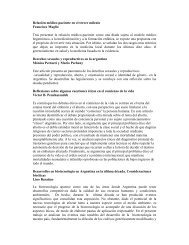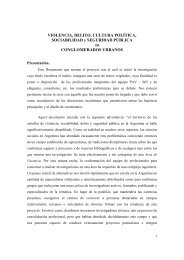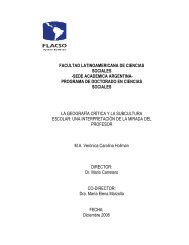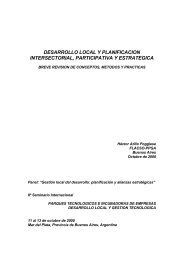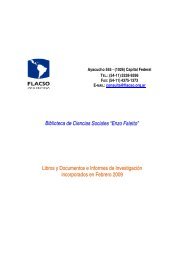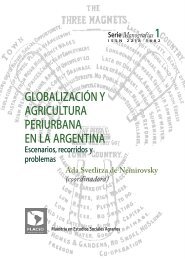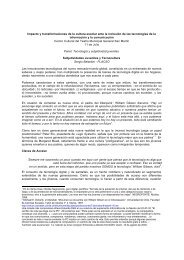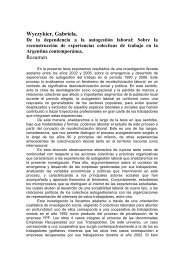Mercedes Botto Andrea Carla Bianculli - Flacso
Mercedes Botto Andrea Carla Bianculli - Flacso
Mercedes Botto Andrea Carla Bianculli - Flacso
Create successful ePaper yourself
Turn your PDF publications into a flip-book with our unique Google optimized e-Paper software.
what was called the Final Regime towards a Common Customs Union (RAFUA/Régimen Final<br />
hacia la Unión Aduanera), which established an extra period – a unique and maximum closing date<br />
of four years – for certain sectors and products. These were given some extra time to restructure<br />
themselves. This meant that they could keep the national tariffs within the intra-zone trade, but<br />
these would have to disappear gradually and automatically until 199939. Argentina included 221<br />
products under this regime, basically those regarding the steel and iron sectors, textiles, footwear,<br />
and paper, all of which still continue to be exempted.<br />
The textile sector constitutes a paradoxical case40. Apart from including this sector in the RAFUA<br />
and creating a special committee aimed at elaborating a proposal for an intra-zone regulatory policy,<br />
the member states agreed on exempting it from the customs union as well. Hence, the current<br />
national schemes would be applied to the textile sector, which in Argentina reached the<br />
consolidated schedules of the WTO. Thus, in practice, Argentina maintained its policy of charging<br />
specific duties to those textile products coming from third countries, and exempted Mercosur<br />
countries, even when these were included in the RAFUA. It is noteworthy that all Mercosur<br />
partners adhered to the textile and clothing agreement established within the WTO in order to<br />
allow for the application of safeguards clauses to these products imports.<br />
In sum, the four countries got to Ouro Preto with a CET and four exception lists, each of which<br />
had a particular mechanism for its future elimination. The first of these lists contained the exclusion<br />
of the CET for those products already under the RAFUA, while the second list included the<br />
national lists of specific exceptions to the customs union – such as textiles and sugar. Both the third<br />
and fourth lists were sectoral lists regarding capital, and computer and telecommunications goods,<br />
where Brazil, under the request of Argentina, committed itself to the reduction of the aliquota<br />
before 200641. 39 Some of the products included under this regime – namely, the steel sector – were also subject to quotas,<br />
while others – such as sugar and automotive – were not included in the intra-Mercosur trade liberalization<br />
scheme. This was due to the considerable divergences member countries exhibited, especially Argentina and<br />
Brazil, in terms of their national policies towards these sectors. A so called Grupo Ad Hoc was commissioned<br />
the definition of a regime that should adequate the sugar sector to the customs union – the CET and the free<br />
trade zone – while an Ad Hoc Technical Committee was requested to elaborate before June 1, 1995, a proposal<br />
for a Common Car Regime that should come into force on January 1, 2000.<br />
40 When discussing this tariff, Argentine negotiators found that the sector relied on very specific and high<br />
rights, and protection regimes quite different from those of other countries. In June 1994, after different<br />
analyses and studies had been carried out, the government established a maximum tariff of 20% for the<br />
confection, 16 to 18% for fabrics, and 12 to 14% for spun. In December 1994, and given the great pressure<br />
exercised by the textile sector, a final decision was made: the sector would be excluded from the CET and<br />
each country would keep its own tariff policy for textiles.<br />
41 While the average level of the CET was fixed at approximately 11%, tariff levels were allowed to vary<br />
between 0 and 20% across industries: the lowest tariffs were allocated to input and materials, intermediate<br />
tariffs were charged on semi-finished industrial goods, and the highest tariffs were assigned to final<br />
manufactures. Following the pattern of intra-Mercosur tariffs, exceptions were also granted. Thus, certain<br />
imports would enjoy tariff rates different from the CET. Nevertheless, it was agreed that the import taxes for<br />
these exempt products would converge linearly and automatically toward the CET by the year 2001, and by<br />
the year 2006 for those exempt products coming from Paraguay. In addition, exceptions to the CET were<br />
granted for capital goods imports – namely, machines and equipment – computers, and telecommunications.<br />
A CET was also established for textiles, but the four partners agreed that this would not be put into practice<br />
immediately. However, and in spite of these exceptions, in 1996 on average countries were quite close to the<br />
32



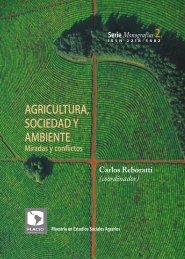
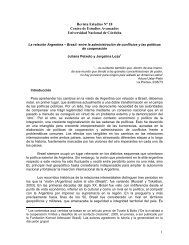
![[P] Disertacion.Melisa.Galvano.pdf - Flacso](https://img.yumpu.com/14596629/1/184x260/p-disertacionmelisagalvanopdf-flacso.jpg?quality=85)
